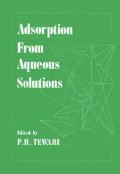Abstract
Adsorption of three metal ions (Cd2+, Co2+, Zn2+) onto amorphous iron oxyhydroxide has been studied in the presence of several strongly binding anionic adsorbates (SeO 2-4 , SeO 2-3 , AsO 3-4 , AsO 3-3 , CrO 2-4 , PO -34 ). The anions either increase or have no effect on trace metal adsorption, indicating that competition between the anions and cations for surface sites is relatively minor. The results cannot be explained by electrostatic interactions unless the relative acidities of the anions are very different at the surface than in solution. The most likely cause of the enhanced metal adsorption in some systems is that a secondary surface phase forms, and the metals bind more strongly to the new phase than they do to the original substrate. The secondary phase appears to be an iron-anion solid rather than a trace metal-anion solid. In systems where a new surface does not form, electrostatic and competitive interactions are somehow suppressed, which may indicate that anion adsorption sites are physically and electrically isolated from cation adsorption sites.
Access this chapter
Tax calculation will be finalised at checkout
Purchases are for personal use only
Preview
Unable to display preview. Download preview PDF.
References
J. Leckie and R. James, Control mechanisms for trace metals in natural waters, in: “Aquatic Environmental Chemistry of Metals” A.J. Rubin, ed., Ann Arbor Science Foundation, Ann Arbor, MI (1974).
L.J. Stryker and E. Matijevic, Adsorption of hydrolyzed hafnium ions on glass, in: “Adsorption from Aqueous Solution”, W. Weber and E. Matijevic, eds., Advances in Chemistry Series #79, American Chemical Society, Washington, DC (1968).
T. Wakamatsu and D.W. Fuerstenau, The effect of hydrocarbon chain length on the adsorption of sulfonates at the solid/ water interface, in: “Adsorption from Aqueous Solution”, W. Weber and E. Matijevic, eds., Advances in Chemistry Series #79, American Chemical Society, Washington, DC (1968).
E.A. Jenne, Controls on Mn, Fe, Co, Ni, Cu, and Zn concentrations in soils and water: the significant role of hydrous Mn and Fe oxides, in: “Adsorption from Aqueous Solution”, W. Weber and E. Matijevic, eds., Advances in Chemistry Series #79, American Chemical Society, Washington, DC (1968).
M.A. Anderson, J.F. Ferguson and J. Gavis, J. Colloid Interface Sci. 54: 391 (1976).
G.A. Parks and P.L. de Bruyn, J. Phys. Chem. 66: 967 (1962).
J.A. Davis, R.O. James and J.O. Leckie, J. Colloid Interface Sci. (63(3): 480 (1978).
W. Stumm, C. Huang and S. Jenkins, Croatica Chim. Acta 43: 223 (1970).
R. James and T. Healy, J. Colloid Interface Sci. 40: 65 (1972).
J.A. Davis and J.O. Leckie, Speciation of adsorbed ions at the oxide/water interface, in: “Chemical Modeling in Aqueous Systems”, E.A. Jenne, ed., Advances in Chemistry Series #93, American Chemical Society, Washington, DC (1979).
H. Hohl and W. Stumm, J. Colloid Interface Sci. 55: 281 (1976).
M.M. Benjamin and J.O. Leckie, J. Colloid Interface Sci. accepted for publication.
J.A. Davis and J.O. Leckie, J. Colloid Interface Sci. 67: 90 (1978).
J.A. Davis and J.O. Leckie, J. Colloid Interface Sci. 74: 32 (1980).
M.M. Benjamin and J.O. Leckie, Competitive adsorption of Cd, Cu, Zn, and Pb on amorphous iron oxyhydroxides, submitted for publication.
J.O. Leckie, M.M. Benjamin, K. Hayes, G. Kaufman and S. Altmann, “Adsorption/Coprecipitation of Trace Elements from Water with Iron Oxyhydroxide”, prepared for the Electric Power Research Institute as EPRI-RP-910 (1979).
M.L. Pierce and C.B. Moore, Environ. Sci. and Technol. 14: 214 (1980).
P.H. Tewari and W. Lee, J. Colloid Interface Sci. 52: 77 (1975).
R.O. James and T.W. Healy, J. Colloid Interface Sci. 40: 53 (1972).
Author information
Authors and Affiliations
Editor information
Editors and Affiliations
Rights and permissions
Copyright information
© 1981 Plenum Press, New York
About this chapter
Cite this chapter
Benjamin, M.M., Bloom, N.S. (1981). Effects of Strong Binding of Anionic Adsorbates on Adsorption of Trace Metals on Amorphous Iron Oxyhydroxide. In: Tewari, P.H. (eds) Adsorption From Aqueous Solutions. Springer, Boston, MA. https://doi.org/10.1007/978-1-4613-3264-0_3
Download citation
DOI: https://doi.org/10.1007/978-1-4613-3264-0_3
Publisher Name: Springer, Boston, MA
Print ISBN: 978-1-4613-3266-4
Online ISBN: 978-1-4613-3264-0
eBook Packages: Springer Book Archive

